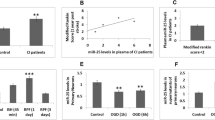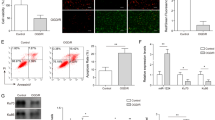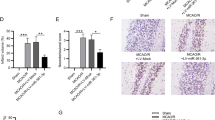Abstract
Chronic cerebral hypoperfusion (CCH) characterized by global cerebral ischemia is an important risk factor contributing to the development of dementia. MicroRNAs (miRNAs) play important roles in the cellular adaptation to long-term ischemia/hypoxia by turning off or on the expression of target genes. MiR-181c is widely expressed in the nervous system, and tripartite motif 2 (TRIM2) is one of its target genes. In this work, we had identified that progressive spatial memory deficiency was induced in the bilateral common carotid artery occlusion (2-VO) rat models. Meanwhile, inhibition of miR-181c expression and upregulation of TRIM2 in the hippocampus of 2-VO rats were found accompanying with reduction in the dendritic branching and dendrite spine density of the hippocampal neurons. Viral vector-mediated miR-181c delivery might improve the cognitive deficiency via TRIM2 on neurofilament light (NF-L) ubiquitination resulting in remodeling of the hippocampal neurons as well as increase in N-methyl-d-aspartate receptor 1 (NR1) subunit cell surface expression. Meanwhile, miR-181c might rescue the cellular activity from ischemia/hypoxia. These results indicated a novel miRNA-mediated mechanism involving miR-181c and TRIM2 in the cognitive impairment induced by CCH and provided a rationale for the development of miRNA-based strategies for prevention of dementia.








Similar content being viewed by others
References
Muller M, Kuiperij HB, Claassen JA, Kusters B, Verbeek MM (2014) MicroRNAs in Alzheimer’s disease: differential expression in hippocampus and cell-free cerebrospinal fluid. Neurobiol Aging 35(1):152–158. doi:10.1016/j.neurobiolaging.2013.07.005
Qiu L, Zhang W, Tan EK, Zeng L (2014) Deciphering the function and regulation of microRNAs in Alzheimer’s disease and Parkinson’s disease. ACS Chem Neurosci 5(10):884–894. doi:10.1021/cn500149w
He M, Liu Y, Wang X, Zhang MQ, Hannon GJ, Huang ZJ (2012) Cell-type-based analysis of microRNA profiles in the mouse brain. Neuron 73(1):35–48. doi:10.1016/j.neuron.2011.11.010
Chen CL, Liu H, Guan X (2013) Changes in microRNA expression profile in hippocampus during the acquisition and extinction of cocaine-induced conditioned place preference in rats. J Biomed Sci 20:96. doi:10.1186/1423-0127-20-96
Olde Loohuis NF, Kole K, Glennon JC, Karel P, Van der Borg G, Van Gemert Y, Van den Bosch D, Meinhardt J et al (2015) Elevated microRNA-181c and microRNA-30d levels in the enlarged amygdala of the valproic acid rat model of autism. Neurobiol Dis 80:42–53. doi:10.1016/j.nbd.2015.05.006
Schonrock N, Humphreys DT, Preiss T, Gotz J (2012) Target gene repression mediated by miRNAs miR-181c and miR-9 both of which are down-regulated by amyloid-beta. J Mol Neurosci 46(2):324–335. doi:10.1007/s12031-011-9587-2
Reymond A, Meroni G, Fantozzi A, Merla G, Cairo S, Luzi L, Riganelli D, Zanaria E et al (2001) The tripartite motif family identifies cell compartments. EMBO J 20(9):2140–2151. doi:10.1093/emboj/20.9.2140
Khazaei MR, Bunk EC, Hillje AL, Jahn HM, Riegler EM, Knoblich JA, Young P, Schwamborn JC (2011) The E3-ubiquitin ligase TRIM2 regulates neuronal polarization. J Neurochem 117(1):29–37. doi:10.1111/j.1471-4159.2010.06971.x
Benson DL, Mandell JW, Shaw G, Banker G (1996) Compartmentation of alpha-internexin and neurofilament triplet proteins in cultured hippocampal neurons. J Neurocytol 25(3):181–196
Ehlers MD, Fung ET, O’Brien RJ, Huganir RL (1998) Splice variant-specific interaction of the NMDA receptor subunit NR1 with neuronal intermediate filaments. J Neurosci 18(2):720–730
Ratnam J, Teichberg VI (2005) Neurofilament-light increases the cell surface expression of the N-methyl-D-aspartate receptor and prevents its ubiquitination. J Neurochem 92(4):878–885. doi:10.1111/j.1471-4159.2004.02936.x
Gorelick PB, Scuteri A, Black SE, Decarli C, Greenberg SM, Iadecola C, Launer LJ, Laurent S et al (2011) Vascular contributions to cognitive impairment and dementia: a statement for healthcare professionals from the american heart association/american stroke association. Stroke 42(9):2672–2713. doi:10.1161/STR.0b013e3182299496
de la Torre JC (2000) Impaired cerebromicrovascular perfusion. Summary of evidence in support of its causality in Alzheimer’s disease. Ann N Y Acad Sci 924:136–152
Wierenga CE, Hays CC, Zlatar ZZ (2014) Cerebral blood flow measured by arterial spin labeling MRI as a preclinical marker of Alzheimer’s disease. J Alzheimers Dis 42(Suppl 4):S411–S419. doi:10.3233/JAD-141467
Bell RD, Zlokovic BV (2009) Neurovascular mechanisms and blood-brain barrier disorder in Alzheimer’s disease. Acta Neuropathol 118(1):103–113. doi:10.1007/s00401-009-0522-3
Kulshreshtha R, Ferracin M, Wojcik SE, Garzon R, Alder H, Agosto-Perez FJ, Davuluri R, Liu CG et al (2007) A microRNA signature of hypoxia. Mol Cell Biol 27(5):1859–1867. doi:10.1128/MCB.01395-06
Pocock R (2011) Invited review: decoding the microRNA response to hypoxia. Pflugers Arch 461(3):307–315. doi:10.1007/s00424-010-0910-5
Ohkawa N, Kokura K, Matsu-Ura T, Obinata T, Konishi Y, Tamura TA (2001) Molecular cloning and characterization of neural activity-related RING finger protein (NARF): a new member of the RBCC family is a candidate for the partner of myosin V. J Neurochem 78(1):75–87
Balastik M, Ferraguti F, Pires-da Silva A, Lee TH, Alvarez-Bolado G, Lu KP, Gruss P (2008) Deficiency in ubiquitin ligase TRIM2 causes accumulation of neurofilament light chain and neurodegeneration. Proc Natl Acad Sci U S A 105(33):12016–12021. doi:10.1073/pnas.0802261105
Ni J, Ohta H, Matsumoto K, Watanabe H (1994) Progressive cognitive impairment following chronic cerebral hypoperfusion induced by permanent occlusion of bilateral carotid arteries in rats. Brain Res 653(1–2):231–236
Sun MK, Xu H, Alkon DL (2002) Pharmacological protection of synaptic function, spatial learning, and memory from transient hypoxia in rats. J Pharmacol Exp Ther 300(2):408–416
Schindler U, Rush DK, Fielding S (1984) Nootropic drugs: animal models for studying effects on cognition. Drug Dev Res 4(4):567–576
Wu X, Sun J, Zhang X, Li X, Liu Z, Yang Q, Li L (2014) Epigenetic signature of chronic cerebral hypoperfusion and beneficial effects of S-adenosylmethionine in rats. Mol Neurobiol 50(3):839–851. doi:10.1007/s12035-014-8698-5
Paxinos G, Watson CR, Emson PC (1980) AChE-stained horizontal sections of the rat brain in stereotaxic coordinates. J Neurosci Methods 3(2):129–149
Langhammer CG, Previtera ML, Sweet ES, Sran SS, Chen M, Firestein BL (2010) Automated Sholl analysis of digitized neuronal morphology at multiple scales: whole cell Sholl analysis versus Sholl analysis of arbor subregions. Cytometry A 77(12):1160–1168. doi:10.1002/cyto.a.20954
Liu H, Xing A, Wang X, Liu G, Li L (2012) Regulation of beta-amyloid level in the brain of rats with cerebrovascular hypoperfusion. Neurobiol Aging 33(4):826.e831–826.e842. doi:10.1016/j.neurobiolaging.2011.05.027
Ylikallio E, Poyhonen R, Zimon M, De Vriendt E, Hilander T, Paetau A, Jordanova A, Lonnqvist T et al (2013) Deficiency of the E3 ubiquitin ligase TRIM2 in early-onset axonal neuropathy. Hum Mol Genet 22(15):2975–2983. doi:10.1093/hmg/ddt149
Thrower JS, Hoffman L, Rechsteiner M, Pickart CM (2000) Recognition of the polyubiquitin proteolytic signal. EMBO J 19(1):94–102. doi:10.1093/emboj/19.1.94
Jing Z, Shi C, Zhu L, Xiang Y, Chen P, Xiong Z, Li W, Ruan Y et al (2015) Chronic cerebral hypoperfusion induces vascular plasticity and hemodynamics but also neuronal degeneration and cognitive impairment. J Cereb Blood Flow Metab 35(8):1249–1259. doi:10.1038/jcbfm.2015.55
Woldemichael BT, Mansuy IM (2016) Micro-RNAs in cognition and cognitive disorders: potential for novel biomarkers and therapeutics. Biochem Pharmacol 104:1–7. doi:10.1016/j.bcp.2015.11.021
Baumgart M, Groth M, Priebe S, Appelt J, Guthke R, Platzer M, Cellerino A (2012) Age-dependent regulation of tumor-related microRNAs in the brain of the annual fish Nothobranchius furzeri. Mech Ageing Dev 133(5):226–233. doi:10.1016/j.mad.2012.03.015
Lakomy R, Sana J, Hankeova S, Fadrus P, Kren L, Lzicarova E, Svoboda M, Dolezelova H et al (2011) MiR-195, miR-196b, miR-181c, miR-21 expression levels and O-6-methylguanine-DNA methyltransferase methylation status are associated with clinical outcome in glioblastoma patients. Cancer Sci 102(12):2186–2190. doi:10.1111/j.1349-7006.2011.02092.x
Delay C, Mandemakers W, Hebert SS (2012) MicroRNAs in Alzheimer’s disease. Neurobiol Dis 46(2):285–290. doi:10.1016/j.nbd.2012.01.003
Ma X, Zhou J, Zhong Y, Jiang L, Mu P, Li Y, Singh N, Nagarkatti M et al (2014) Expression, regulation and function of microRNAs in multiple sclerosis. Int J Med Sci 11(8):810–818. doi:10.7150/ijms.8647
Roncon P, Soukupova M, Binaschi A, Falcicchia C, Zucchini S, Ferracin M, Langley SR, Petretto E et al (2015) MicroRNA profiles in hippocampal granule cells and plasma of rats with pilocarpine-induced epilepsy—comparison with human epileptic samples. Sci Rep 5:14143. doi:10.1038/srep14143
Somel M, Guo S, Fu N, Yan Z, Hu HY, Xu Y, Yuan Y, Ning Z et al (2010) MicroRNA, mRNA, and protein expression link development and aging in human and macaque brain. Genome Res 20(9):1207–1218. doi:10.1101/gr.106849.110
Seeger T, Haffez F, Fischer A, Koehl U, Leistner DM, Seeger FH, Boon RA et al (2013) Immunosenescence-associated microRNAs in age and heart failure. Eur J Heart Fail 15(4):385–393. doi:10.1093/eurjhf/hfs184
Hebert SS, Horre K, Nicolai L, Papadopoulou AS, Mandemakers W, Silahtaroglu AN, Kauppinen S, Delacourte A et al (2008) Loss of microRNA cluster miR-29a/b-1 in sporadic Alzheimer’s disease correlates with increased BACE1/beta-secretase expression. Proc Natl Acad Sci U S A 105(17):6415–6420. doi:10.1073/pnas.0710263105
Nunez-Iglesias J, Liu CC, Morgan TE, Finch CE, Zhou XJ (2010) Joint genome-wide profiling of miRNA and mRNA expression in Alzheimer’s disease cortex reveals altered miRNA regulation. PLoS One 5(2):e8898. doi:10.1371/journal.pone.0008898
Geekiyanage H, Jicha GA, Nelson PT, Chan C (2012) Blood serum miRNA: non-invasive biomarkers for Alzheimer’s disease. Exp Neurol 235(2):491–496. doi:10.1016/j.expneurol.2011.11.026
Schonrock N, Gotz J (2012) Decoding the non-coding RNAs in Alzheimer’s disease. Cell Mol Life Sci 69(21):3543–3559. doi:10.1007/s00018-012-1125-z
Ouyang YB, Lu Y, Yue S, Xu LJ, Xiong XX, White RE, Sun X, Giffard RG (2012) miR-181 regulates GRP78 and influences outcome from cerebral ischemia in vitro and in vivo. Neurobiol Dis 45(1):555–563. doi:10.1016/j.nbd.2011.09.012
Farkas E, Luiten PG, Bari F (2007) Permanent, bilateral common carotid artery occlusion in the rat: a model for chronic cerebral hypoperfusion-related neurodegenerative diseases. Brain Res Rev 54(1):162–180. doi:10.1016/j.brainresrev.2007.01.003
Thompson S, Pearson AN, Ashley MD, Jessick V, Murphy BM, Gafken P, Henshall DC, Morris KT et al (2011) Identification of a novel Bcl-2-interacting mediator of cell death (Bim) E3 ligase, tripartite motif-containing protein 2 (TRIM2), and its role in rapid ischemic tolerance-induced neuroprotection. J Biol Chem 286(22):19331–19339. doi:10.1074/jbc.M110.197707
Kos A, Olde Loohuis N, Meinhardt J, van Bokhoven H, Kaplan BB, Martens GJ, Aschrafi A (2016) MicroRNA-181 promotes synaptogenesis and attenuates axonal outgrowth in cortical neurons. Cell Mol Life Sci. doi:10.1007/s00018-016-2179-0
Fernandez-Martos CM, King AE, Atkinson RA, Woodhouse A, Vickers JC (2015) Neurofilament light gene deletion exacerbates amyloid, dystrophic neurite, and synaptic pathology in the APP/PS1 transgenic model of Alzheimer’s disease. Neurobiol Aging 36(10):2757–2767. doi:10.1016/j.neurobiolaging.2015.07.003
Froehner SC (1993) Regulation of ion channel distribution at synapses. Annu Rev Neurosci 16:347–368. doi:10.1146/annurev.ne.16.030193.002023
Sheng M, Pak DT (1999) Glutamate receptor anchoring proteins and the molecular organization of excitatory synapses. Ann N Y Acad Sci 868:483–493
Mabb AM, Ehlers MD (2010) Ubiquitination in postsynaptic function and plasticity. Annu Rev Cell Dev Biol 26:179–210. doi:10.1146/annurev-cellbio-100109-104129
Yang HY, Liu Y, Xie JC, Liu NN, Tian X (2015) Effects of repetitive transcranial magnetic stimulation on synaptic plasticity and apoptosis in vascular dementia rats. Behav Brain Res 281:149–155. doi:10.1016/j.bbr.2014.12.037
Zhang Y, Li P, Feng J, Wu M (2016) Dysfunction of NMDA receptors in Alzheimer’s disease. Neurol Sci. doi:10.1007/s10072-016-2546-5
Ma SH, Zhuang QX, Shen WX, Peng YP, Qiu YH (2015) Interleukin-6 reduces NMDAR-mediated cytosolic Ca(2)(+) overload and neuronal death via JAK/CaN signaling. Cell Calcium 58(3):286–295. doi:10.1016/j.ceca.2015.06.006
Lo FS, Blue ME, Erzurumlu RS (2016) Enhancement of postsynaptic GABAA and extrasynaptic NMDA receptor-mediated responses in the barrel cortex of Mecp2-null mice. J Neurophysiol 115(3):1298–1306. doi:10.1152/jn.00944.2015
Zhang L, Li YJ, Wu XY, Hong Z, Wei WS (2015) MicroRNA-181c negatively regulates the inflammatory response in oxygen-glucose-deprived microglia by targeting toll-like receptor 4. J Neurochem 132(6):713–723. doi:10.1111/jnc.13021
Wang H, Li J, Chi H, Zhang F, Zhu X, Cai J, Yang X (2015) MicroRNA-181c targets Bcl-2 and regulates mitochondrial morphology in myocardial cells. J Cell Mol Med 19(9):2084–2097. doi:10.1111/jcmm.12563
Acknowledgements
This work was supported by National Natural Science Foundation of China (No. 81271310) and Key project of science and technology program of Beijing Municipal Education Commission (No. KZ201610025021).
Author information
Authors and Affiliations
Corresponding author
Ethics declarations
Conflict of Interest
The authors declare that they have no conflict of interest.
Electronic supplementary material
Fig. S1
Nissl’s staining of hippocampus from sham-operated and 2-VO rats (upper panels) (Scale bar=200 μm). The bottom panels were high magnifications of labeled box, respectively (Scale bar=20 μm). (JPEG 122 kb)
Fig. S2
Fluorescent observation of brain slices with lenti-vector injection. (A) Brain slices were examined under inverted fluorescent microscope. Green fluorescence was observed in CA1 area of hippocampus from sham+NC group. (B) High magnification of labeled box in A (Scale bar=200 μm). (JPEG 564 kb)
Rights and permissions
About this article
Cite this article
Fang, C., Li, Q., Min, G. et al. MicroRNA-181c Ameliorates Cognitive Impairment Induced by Chronic Cerebral Hypoperfusion in Rats. Mol Neurobiol 54, 8370–8385 (2017). https://doi.org/10.1007/s12035-016-0268-6
Received:
Accepted:
Published:
Issue Date:
DOI: https://doi.org/10.1007/s12035-016-0268-6




